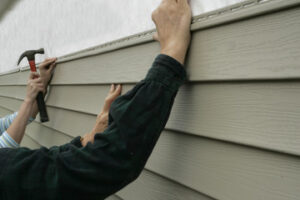Licensed contractors are more likely to adhere to local building codes and regulations, which is crucial for your home’s safety and structural integrity. They also offer transparent pricing and work guarantees.

Siding Contractors Charleston SC understand the nuances of various siding materials and their advantages. They recommend the right material based on your specific needs, from the cost-effectiveness of vinyl to the durability and classic appearance of wood.
Embarking on a siding project requires professional skill and expertise, as well as proper equipment and materials. A quality siding installation enhances your home’s aesthetic, energy efficiency, and resilience against the elements. To avoid costly mistakes and delays, you should choose a contractor with extensive experience in siding repair and replacement, as well as licensing, insurance, and transparency in pricing.
The first step in evaluating contractors is to schedule an initial consultation. This is your opportunity to ask targeted questions and assess their technical knowledge, work ethic, and communication skills. If they are punctual, respectful of your property, and provide clear answers, you can trust that they will deliver quality results.
During the consultation, you should also inquire about their preferred siding materials and their approach to projects. A reputable contractor should be able to explain the advantages and disadvantages of each material and recommend the best solution for your unique needs. They should also be able to provide you with a detailed quote, including the cost of materials, labor, and any warranties or guarantees offered.
After you’ve compiled a list of potential contractors, request quotes from each of them. Compare each of the details included in each quote, and pay special attention to any warranties or guarantees offered by each one. Then, select the contractor that offers you the most value for your money. Licensing and insurance are important considerations, as they protect you from liability and ensure that the job is completed properly.
Experience
Siding installation can be a stressful project, and it’s important to choose a contractor who has extensive experience and a strong reputation. Checking the length of time a company has been in business, online reviews, and testimonials can help you assess their reliability. Additionally, asking for a list of references is essential to evaluate the quality of work, communication skills, and adherence to timelines. Verifying their insurance and business licenses is also crucial for liability protection.
Look for a detailed contract that specifies key project details, including a clear description of the work to be completed. A comprehensive contract can help you avoid disputes and misunderstandings later on. The contract should also include a list of materials and products to be used, as well as pricing and warranties.
When comparing quotes, focus on the labor costs. It’s important to find a contractor who will do a thorough job without overcharging. It’s also important to compare material quality, as low-quality materials can lead to expensive repairs in the future. It’s also a good idea to ask the contractor for their warranty policies and how they address issues that arise during the process. A good warranty will cover both the product and the workmanship. It’s best to choose a siding contractor who is associated with a reputable supplier, such as ABC Supply, so you can be sure that they are using high-quality materials.
Licensing
When it comes to your home’s siding, you want a contractor with experience and professional skill. This ensures you get the best possible results, and a long-lasting, beautiful finish. In addition, a reputable siding contractor will offer transparent pricing and a warranty that covers materials as well as labor. This is especially important if you live in a climate like Wisconsin, where the weather requires specific weatherproofing techniques.
Siding installation is a complex process, and it’s critical that the work is done correctly to avoid costly problems down the road. A licensed contractor can help you choose the right materials, and they’ll also ensure that your project complies with local building codes and safety regulations. This saves you time and money, and it protects your investment.
A license is a good sign that the contractor has met specific standards, and that they’re committed to excellence in their craft. It’s also a good idea to ask for references from past clients. This gives you an honest insight into the contractor’s reliability, communication skills, and artisanship. It’s also helpful to request photos of previous projects, particularly those with a siding style similar to yours.
Another sign of a quality siding contractor is their willingness to provide a written estimate and a timeline for completion. This will help you determine whether they are a fit for your needs and budget. In addition, a quality contractor will have liability insurance, workers’ compensation coverage, and a business license.
Insurance
A good siding contractor will have liability insurance, property damage coverage, and workers’ compensation insurance to protect themselves and their clients in case of an accident or injuries. You can ask for proof of insurance before hiring a contractor to make sure that they are properly covered in the event something goes wrong on your property during the project.
Siding projects can be disruptive to your home, and it is important to find a contractor who will be respectful of your property while working on the project. A good siding contractor will take care to cover any areas of your house that will be affected by the renovation with tarps or other protective coverings, and they will use barriers to prevent damage to walkways or landscaping. They should also provide a detailed timeline to communicate expectations and keep the project on track.
You should also find out if your siding contractor offers warranties on their work. This can protect you against any issues that arise after the installation is complete, such as water infiltration, mold growth, air leaks, and pest infestation. Many manufacturers offer product warranties for their products, which can be complemented by a labor warranty from the siding contractor.
Finally, you should look for online reviews and testimonials from previous customers to get a sense of the contractor’s reputation and reliability. Check for reviews that mention the contractor’s professionalism, quality of workmanship, and adherence to timelines.
Transparency in pricing
When hiring contractors, it’s important to request quotes that provide a complete breakdown of costs. This will help you compare prices and ensure that there are no hidden fees or expenses. Also, check that the contractor is licensed and insured to protect you from liability. A professional contractor will be transparent and honest with you about pricing, timelines, and any potential issues that may arise during the project.
A quality siding installation will enhance your home’s curb appeal, increase its value, and provide critical protection from moisture and the elements. A good contractor will provide detailed consultations, perform accurate measurements, and recommend siding materials that match your style, climate, and budget. Then, they will complete a thorough preparation and inspection to identify any potential issues and make necessary repairs. They will also ensure a smooth installation process that adheres to manufacturer guidelines and prevents air and moisture infiltration, which can lead to costly long-term damage.
Ask for client references and read online reviews to get a sense of the contractor’s quality of work and reliability. Look for positive feedback and testimonials that highlight their professionalism, timeliness, and communication skills. In addition, a good residential siding contractor should be able to offer you a workmanship warranty, which will cover any mistakes or issues that occur during the project.
Reputation
It is crucial to hire a contractor with a good reputation, as this will ensure that you receive high-quality work and satisfaction with the project. The best way to gauge a contractor’s reputation is through customer reviews and testimonials. Ideally, these should highlight the contractor’s professionalism and communication skills. In addition, they should be transparent in their pricing and provide a detailed estimate of the scope of work. For example, a professional siding contractor should include the cost of materials and labor in their quotes, as well as any additional costs (such as permit fees) that may arise during the course of the project.
In addition to evaluating online reviews, it’s important to request references from past clients. This will give you an idea of the contractor’s reliability and customer service, and it will also allow you to see their completed projects in person. Moreover, a local contractor will be more likely to provide you with personalized service and quick response times for any siding repairs or replacements you need.
Additionally, a reputable siding contractor will be licensed and insured. Licensing indicates that the contractor meets industry standards, while insurance protects you in case of unforeseen incidents during the project. Choosing a contractor with the right experience, licensing, and reputation will guarantee a smooth project from start to finish. This will help you save time and money, while ensuring that your home is protected.








